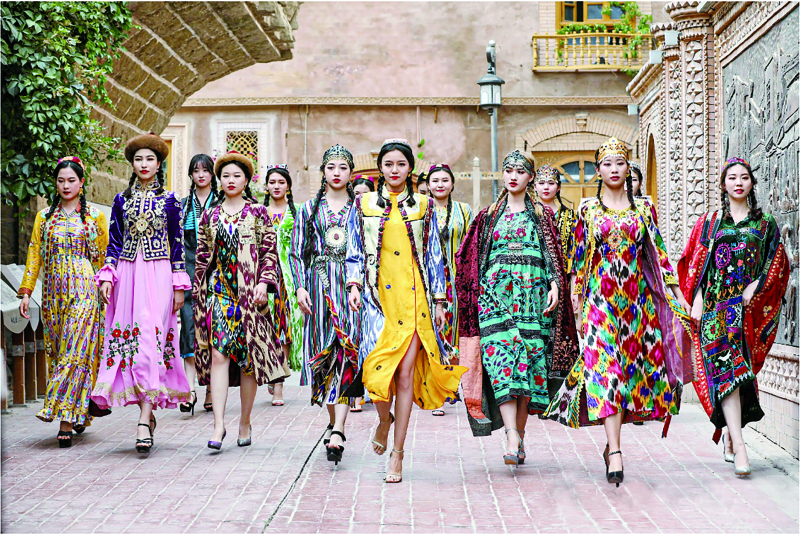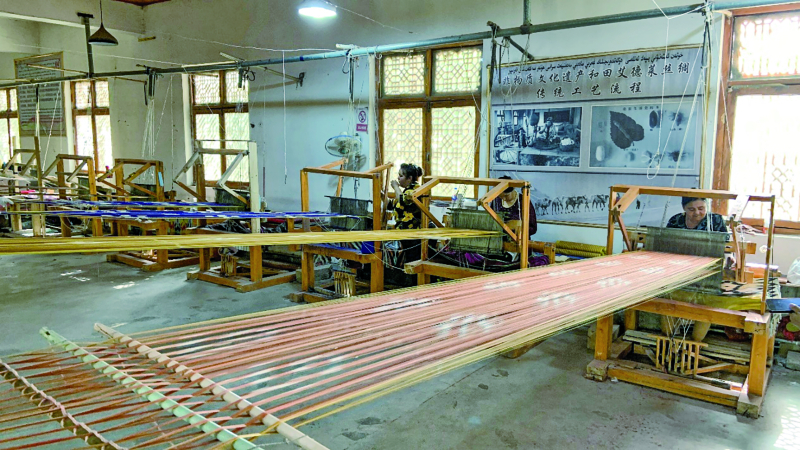Atlas silk, with its brilliant colors and patterns, has been a high-grade silk loved by women of all ethnic groups in Xinjiang since ancient times. As an important part of Chinese traditional culture, Atlas silk not only has aesthetic value, but also cultural value.
Xinjiang is an important city on the ancient Silk Road, and the textile industry has been an important part of its handicraft industry since ancient times. In this land, people have created Atlas silk, the unique silk in Xinjiang with bright colors and various patterns. In 2008, Atlas Silk was listed as a national intangible cultural heritage.

Photo shows an Atlas fashion show in the ancient city of Kashi, Kashi Prefecture, northwest China's Xinjiang Uygur Autonomous Region. (Photo by Ablait Yusup)
The meaning of "Atlas"
Many people who have seen Atlas silk are attracted by its brilliant colors, diverse patterns and soft luster. Why is it called Atlas? In the Uygur language, the "At" of the word "Atlas" means body, while the "las" in this word means wrapping and being comfortable. So the meaning of "Atlas" can be explained as a kind of fabric that can make people feel comfortable wearing it.
The process and evolution of Atlas silk making skills
Atlas silk is produced in Hotan, Kashi and other areas in southern Xinjiang, and has also appeared in Central Asian countries such as Uzbekistan. The Atlas silk, known as “a living fossil along the ancient Silk Road,” has been passed down for over 1,000 years. Making Atlas silk has multiple processes, including silkworm breeding, silk reeling, doubling, coiling, threading, dyeing and spinning. Among them, the most distinctive process is the dyeing process. First, the spinners have to tie the warps and expose the parts to be dyed, then place them in a vat and dye them according to the customer's requirements. They then dye the weft in the base color, arrange the dyed silk threads on the loom according to the pattern, and use the monochrome weft for spinning. During this process, the pattern is naturally formed by the infiltration of the dye. This not only increases the layering of the pattern, but also makes it more varied.

Photo shows spinners make Atlas silk. (Photo by Zhao Shuyang)
The production process of Atlas silk is not static. With the development of technology, craftsmen have gradually improved the process, and the quality and efficiency of Atlas silk production has also gradually improved. Initially, the weft was wrapped in maize leaves, but this was later changed to plastic cloth in the dyeing process to make the pattern clearer. The drying process has also changed from using sand to using a dryer to reduce time and costs. Textile machinery has also been upgraded from manual looms to electric looms, which has also improved production efficiency. It is worth noting that silk fabrics are still produced on manual looms due to their rarity. Therefore, the most luxurious Atlas silk is still hand-made by spinners.
The pattern and color of Atlas silk
Atlas Silk has charming characteristics due to its unique dyeing process and the use of natural materials. This is specifically reflected in its patterns and colors.
Traditional Atlas silk is available in four primary shades: black, red, yellow, and multicolor. It is primarily dyed using plant dyes derived from local agricultural byproducts, including pomegranate flowers, safflower, walnut peel, madder, and sophora japonica flowers.
Atlas silk features a diverse range of patterns: plant motifs with flowers, branches and leaves; decorative elements such as wooden combs, tassels, and gems; and tools like wooden mallets, saws, and sickles. Musical instruments such as Rawap, Tambur, and Dutar are also depicted in these designs.
Various vibrant colors are combined with its dominant hue to create a unique visual effect. Black Atlas silk has the longest history and is often used in clothing for older women. Red Atlas silk, with red designs on a yellow or white ground, is favored by younger women for its vibrant colors. Yellow Atlas silk is often used in clothing for middle-aged women because of its elegant charm. A small amount of blue and green Atlas silk has also appeared in recent years.
Atlas silk is skin-friendly and comfortable. For the local people, Atlas silk is not just a textile, but a spiritual support.

Photo shows an inheritor of the Atlas silk making technique introduces Atlas silk products to tourists at the Intangible Cultural Heritage Expo Park in the old town of Yarkant County, Kashi Prefecture, northwest China's Xinjiang Uygur Autonomous Region. (Photo by Zhang Yun)
Atlas silk was originally the most precious fabric in Xinjiang. With the long-term development of China's society and economy, as well as the continuous improvement of people’s life, everyone can wear clothes made of Atlas silk now.
The beauty of Atlas silk is now being seen by more people outside Xinjiang, captivating a wider audience while preserving its traditional cultural significance. Designers are increasingly incorporating Atlas silk into their creations, creating garments and accessories that resonate with modern aesthetics. A girl in Yining City made horse-face skirts (or mamianqun in Chinese) with Atlas silk, which went viral online. A man from Xinjiang's Ili, wore clothes made of Atlas silk on the streets of Rome, Italy, which attracted a lot of attention.
(A written permission shall be obtained for reprinting, excerpting, copying and mirroring of the contents published on this website. Unauthorized aforementioned act shall be deemed an infringement, of which the actor shall be held accountable under the law.)









